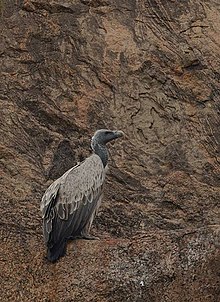The Indian vulture (Gyps indicus) is an Old World vulture
and is closely related to the griffon vulture, G. fulvus. It breeds mainly on
hilly crags in central and peninsular India. The birds in the northern part of
its range once considered a subspecies are now considered a separate species,
the slender-billed vulture Gyps tenuirostris. These were lumped together under
the name long-billed vulture.
The long-billed vulture is a typical vulture, with a bald
head, very broad wings and short tail feathers. It is smaller and less heavily
built than the Eurasian Griffon, usually weighing between 5.5 and 6.3 kg
(12–13.9 lbs) and measuring 80–103 cm (31–41 in) long and 1.96 to 2.38 m (6.4
to 7.8 ft) across the wings. It is distinguished from that species by its less
buff body and wing coverts. It also lacks the whitish median covert bar shown
by Griffon.
The species breeds mainly on cliffs, but is known to use
trees to nest in Rajasthan. Like other vultures it is a scavenger, feeding
mostly from carcasses of dead animals which it finds by soaring over savannah
and around human habitation. They often move in flocks.
The Indian vulture and the white-rumped vulture, G.
bengalensis species have suffered a 99%–97% population decrease in Pakistan and
India. Between 2000-2007 annual decline rates of this species and the
slender-billed vulture averaged over sixteen percent. The cause of this has
been identified as poisoning caused by the veterinary drug diclofenac.
Diclofenac is a non-steroidal anti-inflammatory drug (NSAID) and when given to
working animals it can reduce joint pain and so keep them working for longer.
The drug is believed to be swallowed by vultures with the flesh of dead cattle
who were given diclofenac in the last days of life.
Diclofenac causes kidney failure in several species of
vultures. In March 2006 the Indian Government announced its support for a ban
on the veterinary use of diclofenac. Another NSAID, meloxicam, has been found
to be harmless to vultures and should prove to be an acceptable substitute for
diclofenac. When meloxicam production is increased it is hoped that it will be
as cheap as diclofenac. As of August 2011 the ban for veterinary use for
approximately a year did not prevent diclofenac use across India. Small numbers
of birds have bred across peninsular India, in Karnataka and Tamil Nadu.


No comments:
Post a Comment